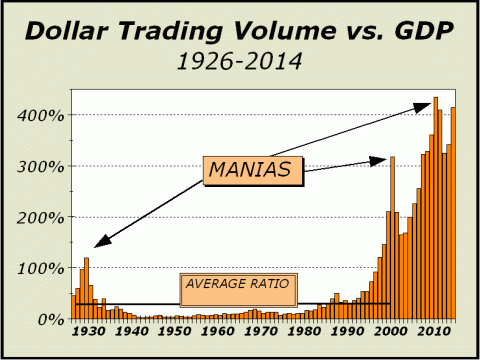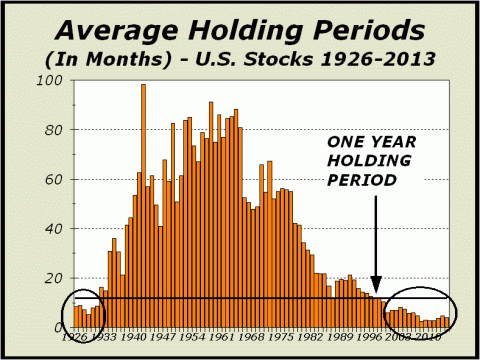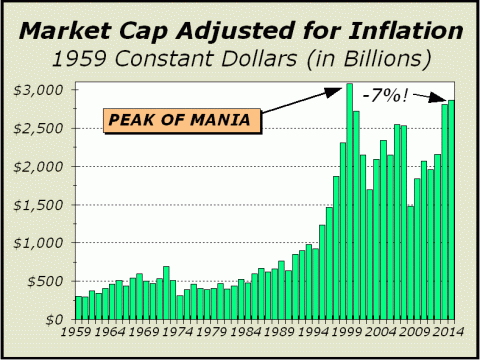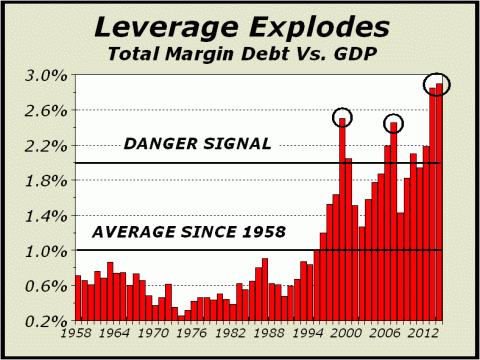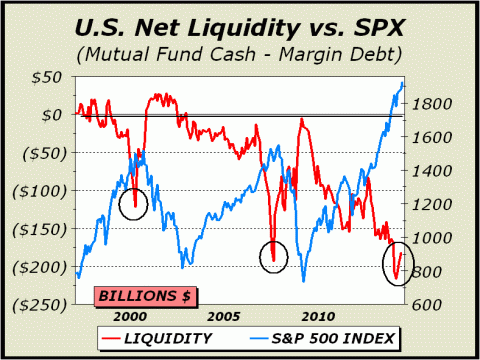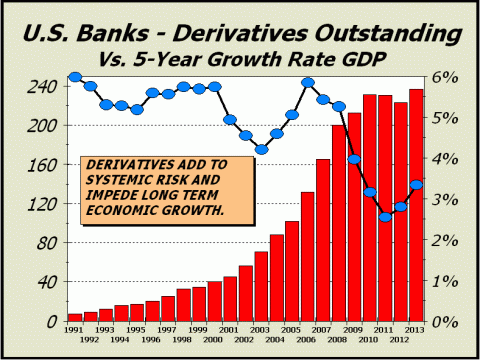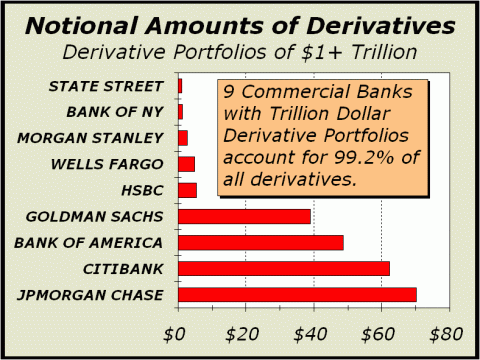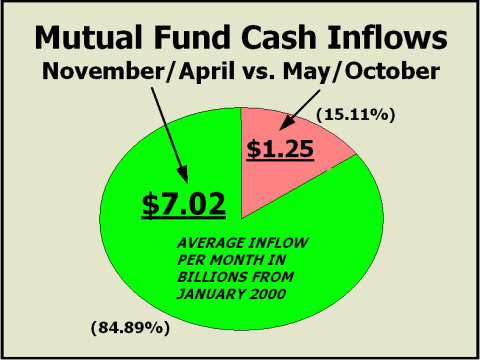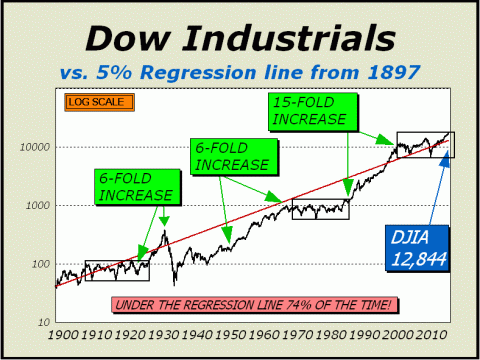
HOME | SUBSCRIBER SECTION | CHART OF THE MONTH | TECH OUTLOOK | COMMENTARY | LINKS | CONTACT US | ARCHIVES
|
- THE GREATEST STOCK MARKET MANIA
OF ALL TIME -
DATED JULY 13, 2014 A SPECIAL REPORT BY ALAN M. NEWMAN, EDITOR CROSSCURRENTS This free feature is now updated only three or four times each year. Our next update will probably not be published until November 2014 |
|
since we first published this website on January 15, 1999. Our readership spans 185 countries.
Our paid
subscription stock market newsletter has only two rationales for its existence;
Please check out the testimonials on our Kudos page. Printable
files of this report accompanied by our forecast are available only to
paid subscribers.
and are chosen for their timeliness and relevance. Déjà Vu. REPRINTED FROM THE MAY 26th ISSUE OF CROSSCURRENTS Our first observations of a potential mania in progress surfaced in the late 1990s as Dollar Trading Volume (DTV) began a near vertical ascent. What had formerly been a staid yet solid bull market suddenly turned into a rip roaring all speed ahead and out of control affair as valuations went out the window. The public was well on the way to “all in” status, equivalent to a high stakes Texas Hold’em game and betting on the River to bail out any poor judgments as the mania took stocks to insane heights. The statistics were startling. In just ten years into the 2000 manic high, DTV rose more than 18-fold from $1.8 trillion to over $32.6 trillion. Despite the enormous influx of cash into both investment and trading, total stock market capitalization climbed only five-and-a-half fold. The average holding period for U.S. stocks fell from more than 19 months to less than 6 months as the theme of buying for the long term quickly became a forgotten refrain. And as greed completely overtook any sense of reality, margin debt ran to an all time high. The stage was set for a collapse. Post collapse, The Fed and the financial industry were unable to face the fact that a veritable mania had come and gone and figured the best cure for the $9 trillion in wealth that had evaporated would be to simply encourage the exact same type of behavior that previously accommodated the financial markets. No moves were taken to stifle another run of inane and excessive risk taking into the 2007 peaks for both stocks and the housing markets. Not even lip service was paid to the burgeoning speculation. As a result, DTV skyrocketed from $18.1 trillion when stocks bottomed in 2002, to $48.3 trillion in 2008. Holding periods fell to the lowest ever, a mere 2.6 months, and margin debt achieved another record high in July 2007, exceeding the March 2000 high by $116 billion. Again, the stage was set for a collapse. No attention whatsoever was paid to the specter of extreme risk. What unfolded was easily predictable. We now find ourselves at a very similar time only seven years later, as if the mania cycle ordinarily repeats in just this fashion, every seventh year. While our featured chart shows DTV falling shy of a new record vs. GDP, at the present pace it will most certainly set another record in 2014. The previous record of $65 trillion in 2010 will easily fall and may even be eclipsed by the Thanksgiving holiday. Average holding periods are now only 3.6 months, so it is again only about the short term. Since long term investment is not a factor, you can bet the farm that all the valuation methodologies you ever read about for stocks no longer matter for the vast majority of players.
We haven’t mentioned program trading in long while and perhaps we should. The official definition is “the purchase or sale of at least 15 different stocks with a total value of $1 million or more,” a process which has typically meant index arbitrage in the past. In practice, if index futures traded at a discount to the constituent issues, program traders would buy the futures and short the constituents, ensuring a profit. If index futures were at a premium to the constituents, program traders would sell the futures and simultaneously buy the constituent stocks, again ensuring a profit. It wasn’t quite that simple 100% of the time but close enough to see that valuations were not a factor and that positions could potentially be unwound almost immediately, trading that was ultimately high frequency. By the end of 1999, 10% of all volume on the NYSE was catalyzed by programs. The growth of program trading was spectacular. The 13-week average of program trading ascended rapidly: May 2002 — 15%
Finally, as of the week of September 21, 2012, programs weighed in at 48.6% of total NYSE volume. But it wasn’t just programs; HFT was completely taking over the arena. Other strategies were constantly added to the mix in huge quantity and we wound up with momentum traders, technical signal traders, “filter” traders, the very same statistical arbitrage traders and even rebate traders, who were rewarded simply for producing volume and the illusion of liquidity. For the first time in market history, it was possible to lose money on trades, yet make money from rebates offered by the exchange where the volume occurred. Did fair valuations of company prospects play a role in any of the churn? Hardly. See the August 19, 2013 issue of Crosscurrents for a more thorough explanation (http://www.cross-currents.net/c081913c.pdf). The twin collapses of 2000-2002 and 2007-2009 have done a great job of scaring the public away from trusting Wall Street and for good reason.
The industry has designed itself to take advantage of the little guy from so many angles that there is little sense to step into the arena. This is one reason we suspect the American Association of Individual Investors (AAII) sentiment tallies continue to display a distinct lack of enthusiasm for stocks. According to the AAII website, the long term average is 39% Bulls and 30.5% Bears. As of last week, Bulls were only 33.1%. In contrast, the Investor’s Intelligence survey of advisors has Bulls averaging 48.2% and Bears at 21.3% over the last two full years. As of last week, Bulls were at 55.1%. That’s a rather startling dichotomy that speaks volumes about the public’s level of trust. Of course, one reason for distrust is the level of misinformation that circulates from both the financial industry, the Federal government and the media. You cannot fool all of the people all of the time. At center, despite one of the longest and most emphatic bull markets in history, constant dollar wealth topped at the end of 1999. Friday’s close was still 7% away. In addition, by February 2014, margin debt ran to over $500 billion for the first time in history, peaking at $502 billion, almost 3% of GDP. Not only is a new wealth record still some distance away, stocks are saddled to the greatest extent ever by leverage and the attendant risk.
Again, we point to the chart at lower right as the best sign of a major stock market peak. While it cannot be utilized as a short term signal, this third astounding levitation is evidence of an impending bear market and a decline in price that is likely to resemble the prior two. Perhaps we won’t collapse by 50%. Perhaps the damage will not extend two years out in time as in did from the 2000 peak. However, our bear market target of Dow 12,471 is roughly 25% lower than today and we would expect at least a full year will be needed to correct margin debt to reasonable levels and to expand the cash-to-assets ratio of mutual funds to the point that they are compelled to seek value.
Dollar Trading Volume is on track to hit a new record of $70 trillion. In a day and age when notional values of derivatives can reach $240 trillion and one bank alone holds a portfolio of $70 trillion, one’s eyes tend to gloss over large numbers; they tend to lose their meaning. We’d advise not to lose perspective. The numbers and the charts are
every bit as astonishing and meaningful
The Chart Of The Year. REPRINTED FROM THE MARCH 30th ISSUE OF CROSSCURRENTS (CHART UPDATED THROUGH MAY) We are told liquidity is driving the market. Prices are rising because investors are flush with cash with nowhere else to go. We are told that prices will continue to rise because stocks remain undervalued. With the Fed’s taper assured, stocks are the only game in town. We’ll attack all the assumptions one by one but let’s begin with our candidate for Chart of the Year. We measure net liquidity by subtracting margin debt from the absolute level of mutual fund cash. While the mutual fund cash to assets ratio is near record lows, the entire stock market is so huge that there is still a substantial amount of cash that could theoretically be spent, either to increase prices or to stop a major decline in its tracks. When liquidity is positive, the market typically has a lot of room to rally. The more liquidity, the more room to rally. However, the arena depends upon speculation to get the juices flowing, thus bull markets thrive on borrowed money and as prices surge higher, liquidity eventually turns negative. This is not unusual. However, when liquidity suddenly plunges to deeply negative levels, as it did in 2000 and 2007, all bets on the bull market continuing are off. As our featured chart clearly illustrates, this is the case we face at this time. Liquidity is not only negative, it is at its most negative level in history and is plunging at a rate that can only be considered terminal. Liquidity went from negative $19.5 billion from October 1999 to $121.3 billion in March 2000, at the very peak of the tech mania. At the time, the steep drop in liquidity was the fastest ever. Liquidity dropped sharply again over the ten months from negative $13.5 billion in August 2006 to negative $192.6 billion in July 2007, just three months before a massive stock market top. And for the third time, liquidity has again plunged—this time in two stages—the last of which has removed another $66 billion in liquidity in only seven months, taking net liquidity to negative $209 billion, well below the 2007 low. We believe this picture qualifies as the Chart of the Year, even though we are but one quarter of the way into 2014. Then again, we expect to see even scarier charts before long. Despite massive ignorance up to the March 2000 tech mania peak and the autumn 2007 mania highs, there is now total agreement that both were incredible bubbles, the kind you see only once in a lifetime….except it happened twice in seven-and-a-half years. In retrospect, we wonder if there could have ever been a more flagrant disregard for risk but then we see our featured chart and wonder no more. For the third time in 14 years, U.S. stocks are in a bubble and far more leveraged than ever before. For the 55 years since 1958, margin debt has averaged only 1% of gross domestic product (GDP). On two occasions, margin debt soared above 2% of GDP and stock prices were soon cut in half. There are only three instances in which stock prices were cut in half in modern history; the crash from 1929-1932, the crash from 2000-2002 and the crash from 2007-2009. Margin debt is now $502 billion and 3% of GDP, triple what passes for average and is so much higher than our danger signal that we are convinced a similar fate as the two previous collapsed bubbles lies in store for U.S. stocks. Although we admit our expectation that prices will be cut in half is a worst case scenario, the odds certainly favor a decline of 30%-35%. As the tech mania in 2000 clearly proved, it is possible to have a phase in which no price is too high and stocks continue to be bid up despite valuations that are even insane. Despite our conviction on February 28, 2000 that Nasdaq was facing a 35% crash in only six weeks, tech stocks kept on rising for another nine days and another 11% on the upside. Truly mind boggling. We are apparently in a similar phase. No price is too high and no risk is too scary to accommodate in the quest for another winning trade. It might all be somewhat more palatable if leverage and liquidity seemed better able to handle the inevitable correction but instead, they are in the worst position since 1929. We believe stocks will crash.
Six Paragraphs On Risk. REPRINTED FROM THE MAY 26th ISSUE The Office of the Comptroller of the Currency (OCC) released the fourth quarter 2013 report on derivatives, showing total notional values of $237 trillion, down a nominal $3 trillion from the third quarter report. Despite a modest pickup in the government’s stated data for GDP, the 5-year trend for growth remains far outpaced by the fantastic growth of derivatives in bank portfolios. It is our view that this gigantic tally represents a fair appraisal of systemic risk and the more risk is maintained, the more impedance is generated to hinder future economic growth. The simplest inference is that America’s best growth years are behind it, a posit that seems increasingly likely when examining the last dozen years.
While derivatives do not necessarily equate directly to leverage, these financial constructs have enabled leverage on a far greater scale than ever seen in our history. We can see vast increases in leverage in every aspect of our society. Federal government debt has more than tripled since 2000 and is rising at an annual rate of over 8.4%. At the current pace, there is not only no hope of ever paying down debt to a manageable size, we are likely ensuring a massive problem in the next 10-20 years when the only solution to accommodate economic growth will be an inflationary phase that makes the 1970s look tame by comparison. Our charts and comments regarding margin debt in the stock market are more proof of how much leverage is built into our society. When former Fed Chairman commented 18 years ago why the Fed had refused to raise margin rates under Reg. T, he posited that alternative methods to raise borrowed money made an increase in margin rates a meaningless move. No doubt the ease of acquiring home equity lines of credit and even loans via credit card advances helped fuel the tremendous mania in 2000. Meanwhile, what the former Fed Chairman did not say was that the Fed’s reluctance to move favored the financial industry, which would have lost one of their big profit centers had margin rates been raised. As usual, the rationale has always been to protect the financial industry. The public interest is avoided. The greatest failing of the Fed has been to avoid any statement about excessive leverage in our society. However, too much debt is a bad thing. Excusing alternative methods of increasing leverage in order to accommodate the financial industry has been a monstrous error. The Fed’s policies have led to an over-utilization of leverage and today’s record levels of margin debt and notional values of derivatives point out that risk continues to reside at the highest levels ever.
There is a wide gap in between the derivative portfolios of the top four commercial bank portfolios and the next five but altogether, they account for 99.2% of all derivatives. We almost suffered a worst case scenario in 1987, another worst case scenario in 1998 and yet another in 2008, yet we remain on track for another worst case scenario as if this is the accepted standard. As we have said on many occasions, it is not a matter of if, but when. A failure of any of these banks in a worst case scenario will likely threaten the entire financial system.
The bull has now endured for 62 months, a full year more than the average of the previous eight bull markets measuring from 1966. Given we now reside in the Dead Zone, the timing seems perfect for a new bear market. Inflows have already turned negative for domestic mutual funds, suffering $5 billion in outflows over the last eight weeks. Our bear market target of Dow 12,471, down 25.5% from the May 13th high of 16,735 remains a viable and reasonable target.
Back To The Future. In our view, 117 years of history is enough to provide a guideline for the future. We use many methods to provide guidelines for our long term targets and one of the simplest is a 5% regression line. Over the really long term, it has been shown that stocks return approximately 5% per annum. It is only since the great secular bull market began 1982 that stocks seem to be capable of 7% per annum (or greater) returns. But then again, it appears the regression line always eventually wins out. Clearly, despite trading above our line for roughly 13 years, the Dow Industrials collapsed in 2009, taking our the line by a huge margin. We're not calling for another decline of that magnitude but we do believe that stocks can crash and we are quite confident that this major index will once again make the journey to the regression line that currently stands at 12,844. .
We've been there before. Déjà vu.
Odds are we have seen
the price highs for the year.
CORRECTION
TARGET DOW 14,719
The good
news?
THE CONTENTS OF THE ENTIRE WEBSITE ARE COPYRIGHT 2014 CROSSCURRENTS PUBLICATIONS, LLC I hope you have enjoyed your visit. Please return again and feel free to invite your friends to visit as well. Alan M. Newman, July 13, 2014 The entire Crosscurrents website has logged close to 4 million visits. All information on this website is prepared from data obtained from sources believed reliable, but not guaranteed by us, and is not considered to be all inclusive. Any stocks, sectors or indexes mentioned on this page are not to be construed as buy, sell, hold or short recommendations. This report is for informational and entertainment purposes only. Persons affiliated with Crosscurrents Publications, LLC may be long or short the securities or related options or other derivative securities mentioned in this report. Our perspectives are subject to change without notice. We assume no responsibility or liability for the information contained in this report. No investment or trading advice whatsoever is implied by our commentary, coverage or charts. |
|
|
